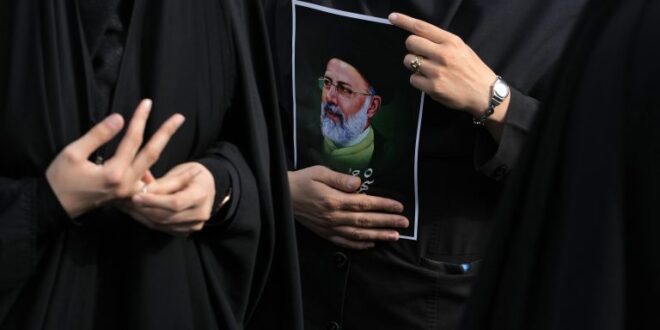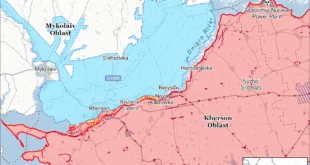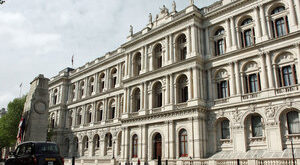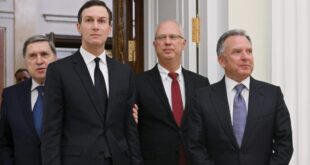- The death of Iran’s President Ibrahim Raisi and Foreign Minister Hossein Amir-Abdollahian might produce modest shifts of emphasis in Iran’s national security strategy.
- The regime is likely to favor hardline candidates in the June 28 special presidential election to replace him, and permission for reformist candidates to run would signal an effort to encourage high turnout.
- The outcome of the special election and subsequent government formation might color Iran’s relations with its “Axis of Resistance” partners as well as its stances on nuclear and other negotiations with the West.
- Periodic indirect talks between Iran and the United States might intensify in an effort to contain regional conflict and achieve additional understandings on Iran’s nuclear program.
Conventional wisdom holds that Iran’s domestic and national security policies will not be altered by the sudden death of President Ibrahim Raisi in a helicopter crash on May 19 – either before the June 28 special election to replace Raisi, or during subsequent leadership competitions thereafter. Supreme Leader Ali Khamenei, who will turn 85 in July, has emphasized policy stability and continuity and has assumed a more active role in day-to-day governance since Raisi’s death. He has met with numerous regional and global leaders visiting Tehran to pay their respects following the deadly accident, reportedly engaging in substantive conversations on bilateral relations.
Most of his meetings have been attended by acting President Mohammad Mokhber, whose elevation to temporary presidential successor, from First Vice President, was approved by Khamenei in line with the Islamic Republic’s constitution. At these meetings, according to state-run broadcast and social media outlets, Khamenei has restated Iranian positions on the war in Gaza, regional policy, and the justifications for attacks by Iran’s regional “Axis of Resistance.” Still, he has seemed to steer clear of any new inflammatory or threatening statements against the United States or its allies.
Although policy is set by the Supreme Leader and his inner circle, Iranian presidents, through their day-to-day control over spending and other policy levers, and their influence over cabinet appointments, can affect how Iranian national security policy is implemented. The special election is therefore potentially meaningful to U.S. and allied assessments of Iranian policy direction. Registration of candidates for the special election will take place between May 30 and June 3, and the regime’s Council of Guardians will vet the candidates to produce a final field within two weeks, before the official campaign period begins on June 12.
Experts broadly expect Khamenei and his aides, including his son and de-facto chief-of-staff Mojtaba, will use the candidate screening authority to shape the field in favor of their preferred candidate to finish the remainder of Raisi’s term. The winner of the special election will presumably have a significant advantage to run in the regular presidential election in mid-2025. Few, if any, experts expect the regime to allow the candidacy of any official who would decisively seek to change Iranian policy. However, the approval of the candidacy of a prominent reformist, such as Majid Ansari, would suggest the regime is trying to encourage high turnout by drawing in moderate voters who otherwise would likely boycott the vote. Ansari is a cleric whose career includes serving as a prison warden. The March 1 parliamentary elections drew a turnout of around 40%, the lowest in the history of the Islamic Republic – signaling widespread disaffection with the country’s leadership and direction.
Experts widely expect the Speaker of the Majles (parliament), Mohammad Baqer Qalibaf, to seek to succeed Raisi. Qalibaf has run unsuccessfully for president several times, but backing from the Leader, which he had not previously had, would significantly improve his chances. Although in recent years Qalibaf has been immersed in a wide range of issues as Majles Speaker and, before that, as Tehran mayor, he has a lengthy background in internal and national security at the upper echelons of the Islamic Revolutionary Guard Corps (IRGC). He was a brigade commander during the 1980s war with Iraq eventually rising to head the IRGC Air Force (1997-2000), which controls Iran’s missile arsenal.
Qalibaf hails from the northeastern city of Mashhad, as does Khamenei and as did Raisi. Qalibaf’s role in suppressing the 1999 student uprising and the 2009 Green Movement rebellion suggests his election would not ease the repressive policies that characterized Raisi’s presidency. Qalibaf’s strong identification with the IRGC implies he would fully engage in and assist IRGC-Qods Force efforts to support Tehran’s Axis of Resistance – including Lebanese Hezbollah, the Houthi movement in Yemen, and pro-Iranian militias in Iraq and Syria – to undermine Israel’s offensive in Gaza and U.S. interests in the region more broadly.
Two other potential candidates with similar views as Qalibaf, and who also ran unsuccessfully previously, are Saeed Jalili and Ali Larijani. Both served during their careers as Iran’s chief nuclear negotiator, but neither produced the compromises needed to forge the multilateral Iran nuclear agreement (JCPOA), which was agreed in 2015, after Jalili’s time in that post. Neither, if elected president, would likely agree in talks with U.S. officials to revive the JCPOA, which President Trump exited in 2018, unless the United States is willing to offer dramatic compromises. But, neither Larijani nor Jalili served in any major IRGC command positions, indicating they would not likely earn the immediate trust of senior IRGC commanders or Iran’s Axis of Resistance partners were either elected president.
Some experts do not discount the chances of another likely candidate, acting President Mohammad Mokhber, whose career focused on the businesses created after Iran’s 1979 Islamic revolution. He has run several regime-run charity organizations and conglomerates known as bonyads (foundations), which generate vast profits that have been used, in part, to fund off-budget operations by the IRGC, including providing financial support to Axis of Resistance partners. In 2021, the U.S. Treasury Department sanctioned Mokhber as head of a key bonyad, the Execution of Imam Khomeini’s Order (EIKO, also known as Setad), referring to the late Supreme Leader Ayatollah Ruhollah Khomeini’s order to assassinate author Salman Rushdie be assassinated for his book, the Satanic Verses, that Khomeini deemed blasphemous.
The sanctions determination said EIKO oversees billions of dollars in assets as “a business juggernaut…that has systematically violated the rights of dissidents by confiscating land and property from opponents of the regime, including political opponents, religious minorities, and exiled Iranians.” The European Union had also sanctioned Mokhber over concerns about Iran’s nuclear program. Mokhber previously worked at the Mostazafan Foundation (the “Foundation of the Oppressed and Disabled”) – another bonyad that manages the regime-linked businesses. He was part of a team of Iranian officials who visited Moscow in October and agreed to supply additional sophisticated armed drones to Russia’s military, suggesting he strongly supports Iran’s alignment with Russia and China at the expense of ties to the West. Mokhber supports Iran’s regional strategy, but lacks close ties to leaders of Iran’s Axis of Resistance partners.
Iran’s regional and global orientation might also undergo some slight modification depending on key appointments to the post-Raisi cabinet. Foreign Minister Hossein Amir-Abdollahian, who perished in the crash alongside Raisi, was steeped in Iran’s efforts to assist its Axis of Resistance partners in pressuring U.S. allies since October 7. The hardliner was deputy foreign minister for Arab and African affairs from 2011 to 2016 and was Iran’s ambassador to Bahrain during 2007 to 2010. His tenure in the small Gulf state coincided with the IRGC -Qods Force effort to destabilize the Sunni Arab-led regime by promoting violent underground movements such as the Al-Ashtar Brigades.
Amir-Abdollahian has been succeeded, on an acting basis, by Ali Bagheri Kani, who is similarly hardline but who, for the past three years, has been Iran’s chief interlocutor with the United States and its allies on Iran’s nuclear program as well as regional issues. He has taken hardline positions that, in part, account for the inability of Biden Administration officials to revive the JCPOA. Since becoming acting minister, Bagheri Kani has stressed policy continuity in meetings with representatives of Axis of Resistance factions, including Hamas, asserting Iran would continue defending Palestinian “righteous resistance” against Israel.
Bagheri Kani’s career focus on nuclear issues implies that, if he is renamed Foreign Minister after the special election, he will likely stress nuclear and other strategic military programs as the core of Iranian national security strategy. And, Raisi’s death came amid press reports that Bagheri Kani had recently held the latest of several indirect meetings with top U.S. Middle East policymaker Brett McGurk in the Sultanate of Oman. Bagheri Kani’s participation in the talks, intended to avoid direct U.S.-Iran conflict as an outgrowth of the October 7-related regional crisis, could further raise doubts among Axis of Resistance faction leaders about his commitment to Iran’s “unity of fronts” strategy against Israel and the United States.
 Eurasia Press & News
Eurasia Press & News




